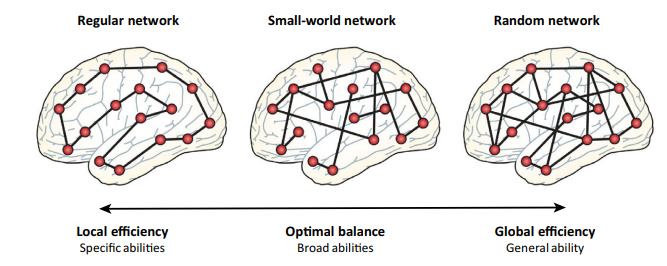Neurotyping
links: Cognition reference:
- Commentary: The Nature of Unsymbolized Thinking
-
https://ouroborista.neocities.org/articles/neurotyping
- His writing on Classpecting, Homestuck’s extended astrology thing 11-3-2021
Neurotyping #
-
The brainweb: Phase synchronizaton and large-scale integration
- “the large-scale integration and the well-known visual-binding problem address the same question but at opposite ends of the spatial continuum. It is parsimonious to assume that they share common mechanisms.”
- Neural synchrony is associated with cognitive integration and a big picture compression of information; neural asynchrony the opposite: a greater focus on details.
-
*Chartlooping, Heatmaps and Other “Movements” Around the Chart
- Impessionistic -> lateral is useful for communication, including to oneself. Thoughts begin impressionistic, but are condensed into lexemes. Relying on impressions can lead one to underestimate certain complexities.
Laterality-Linearity #
- Lin-Lat is a measure of scale, not necessarily complexity; rather what perspective one tends to concern themselves with, whether that be determined by sociology or whatever. But it’s actually laterals that are (kind of autistically) considering the micro scale when you think about it.
- Lateral thinkers immerse themselves in the labrynth of atoms in a complex system, seeing it as a swarm, while linear thinkers simply use the system, while zooming in is more like dividing.
- “Lin/lat axis measures the quantity of an involuntary emergence of associations to a thought”
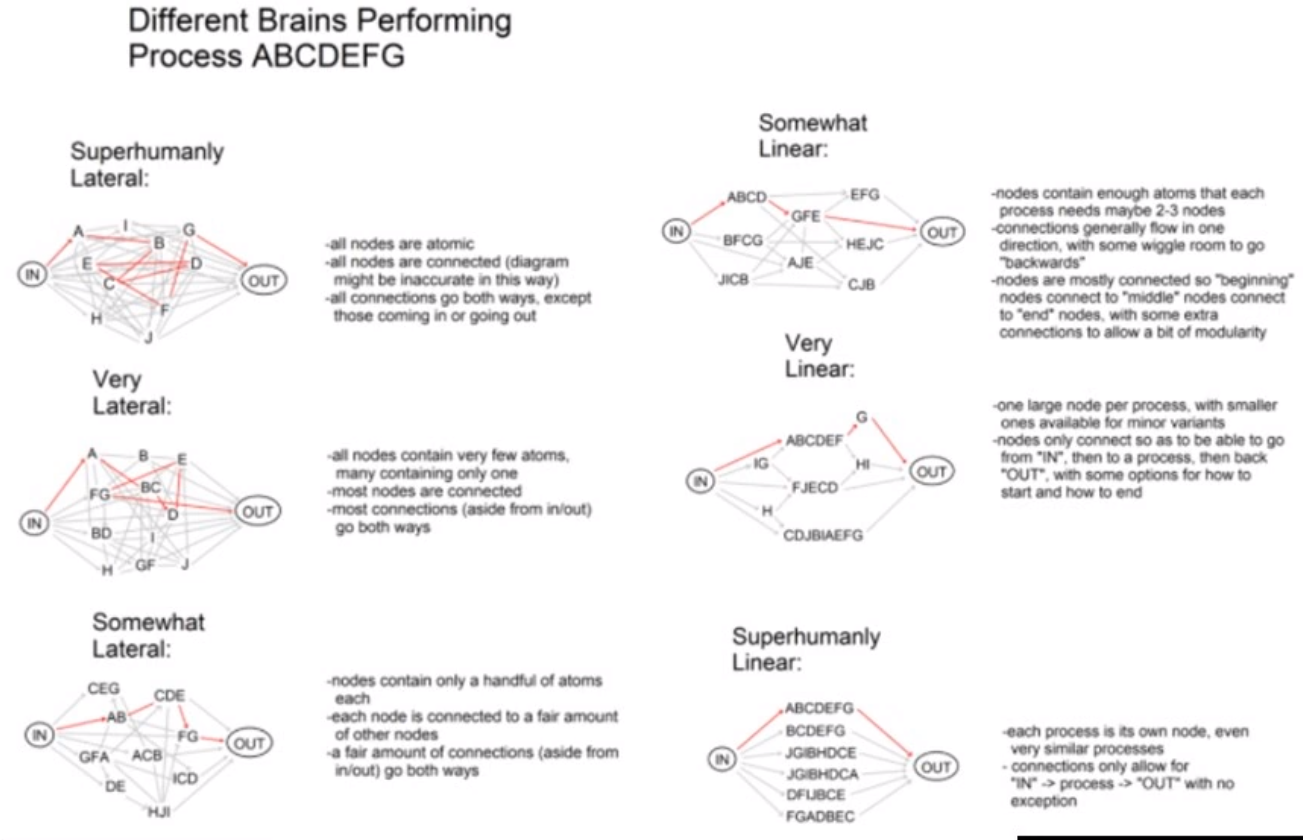
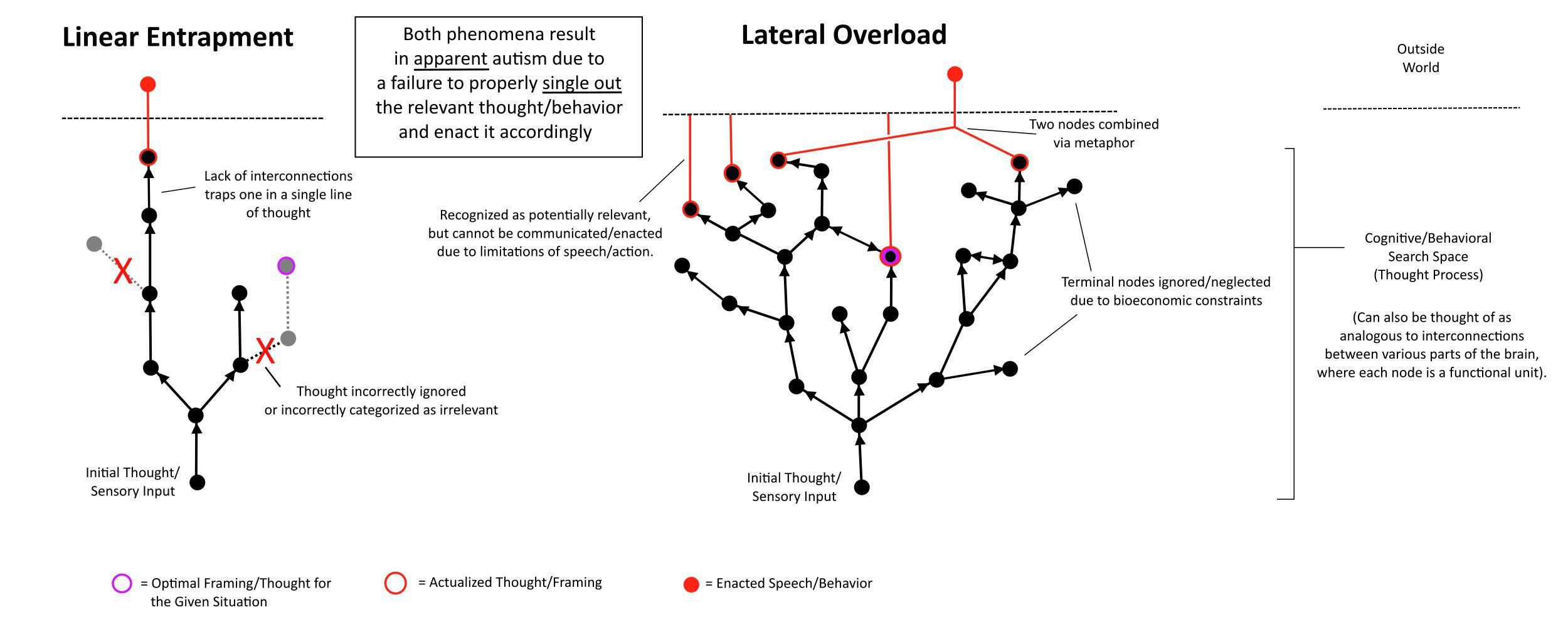
Timecake #
-
The cyclic flow through the Neurotype space is isomorphic to the OODA loop (observe-orient-decide-act, see Boyd’s “Destruction and Creation”). Also isomorphic to a Markov blanket (sensation states->internal states->action states->environmental states->sensation states). Implies that the Free Energy Principle can be mapped to the actualization of the Neurotype space structure as the self-evidencing of…something? Not sure what.
-
Interaction between cognitive agents generates a higher level instantiation of cognition (not necessarily consciousness), which is isomorphic to LinLat type looping (increasing number of agents-> larger effective network->larger effective Laterality due to higher potential for multiple perspectives-> eventual homeomorphism between large network Lat-looped network and small Linear network due to emergent interaction effects->etc.). Implies that multiple linear agents with differing initial conditions (differing LexImp positions?) authentically interacting can effectively generate lateral thinking. This requires authentic dialogue (potential for change) since otherwise the agents of interest will just stay in their established farmings. Having higher Laterality agents as part of the collective of interest can help initialize a frame break, thus reducing the chance for ossification.
-
The LinLat type looping is not perfectly renormalizable however. It isn’t cutoff independent since it matters where you draw the distinction between high Laterality and a looped-Laterality-into-higher-order-Linearity. A high laterality agent can still be more lateral in effect than a collective which is manifesting as a Linear form at that particular level.
-
The higher level networks of agents can impose top-down effects on their constituent agents. For example, a collective which is manifesting as a Linear type of a given level can cause it’s constituent agents to think more Linearly due to the cohesive effects of mimicry and social pressure. Likewise, a collective which is manifesting as a lateral type can influence its constituent agents to be less likely to retain established framings, likewise due to mimicry and social influence.
-
The cyclical flow through the Neurotype space combined with the multiple levels of instantiation afforded by LinLat looping yields the idea of an OODA spiral, where the phase (orientation) of the spiral is held constant (due to the non-renormalizability induced by the scale-dependent cutoffs between multiple levels). This combined with the idea of top-down influence in addition to the bottom-up constituence leads to the idea of a recursive OODA spiral.
-
This combined with the idea of plane complexification from the “Spin” post (where the interaction of agents results in the merging of two Neurotype planes, thus generating a spinor structure, due to the actions of one agent feeding into the sensations of another agent) leads to…something? It would effectively be just a bunch of planes that mutually interconnect, I guess. Not sure what the implications of that are.
-
The LinLat type looping is accessible to individuals to some degree by the internalization of other agents through the construction of accurate mental models of said agents. Engaging in authentic dialogue with those internalized agents can help increase the Laterality of a given individual. However, if all the internalized agents are homogenized in their views, even a high Laterality agent can fall into the entrapment afforded by type-looped Linearity, thus decreasing their cognitive flexibility. In some cases though, where the Laterality of an agent is detrimentally destabilizing, the stability afforded by type-looping to Linearity through the cognitive internalization of other agents may be a good thing. Still not sure what the implications of the recursive OODA spiral are…
-
- Dumb vocab: implicit learning ~= unconscious acquisition.
-
- Digi made up the “flow” thing; mostly as a sort of a macroscopic society-level thing, how information is collapsed from pure potentiality of impressionism, over to the human calculators to rigorously deconstruct it, and brought down into linlex where it’s simple knowledge. The bottom 3 on the top-left->bottom-right aren’t as needed in this process. Of course, the question is if this is a microcosm for something.
- The way he warped the flow to create a brain-like chart is crazy. The latlex quadrant as the corpus callosum is weird. Maybe on a macro cognitive level it’s analogous, but I don’t know how the corpus callosum actually functions - it would have to collapse dense+cloudy strings of information (right brain) simply to dense (left brain) information, probably needing to split the strings in the process, in order to make up for the loss in the “cloudly” imperssionistic dimension into preciseness. But that might not be reflective of its biology whatsoever.
-
- I agree with another commenter that the final product is incorrectly made and doesn’t really reflect the psychology considering the asymmetric geometry bears no relationship to the cohesive/symmetrical relationship implied by the default chart. The closest thing he could’ve gotten to realistic is dividing the quadrants by sub-quadrants, ad infinitum as fractals, which would effectively be the same thing is if you continued the pasting outside the bounds of the chart in both dimensions (1/2 in, 1/2 out, to balance the pasting in the middles), which would leave the graph equally covered with squares, which I think leads to the same result. With that being said, this property of relativity (An overseer is a bookkeeper of the latimp quadrant, etc.) is already illustrated in the original image with its grid already dividing each of type into 16 (25 actually; don’t ask me why. But I guess 100x100 is cool) squares. Going beyond the first order would be excessive.
Alternate Names #
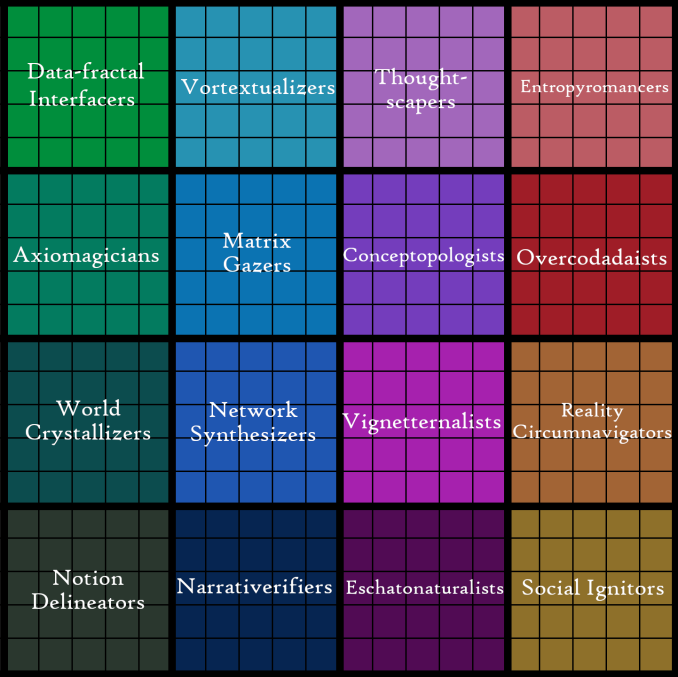 https://docs.google.com/document/d/1n2vKjdJa4c0G3MaqwWMmTgcN-0SP2-3VX_-3WIJh-GQ/edit#
https://docs.google.com/document/d/1n2vKjdJa4c0G3MaqwWMmTgcN-0SP2-3VX_-3WIJh-GQ/edit#
-
A big part of the naming conventions here is that they’re respective to the role they play in the “flow structure” thing
-
To vortextualize is to translate thought juice outside of the Real into lexemes.
-
Thoughtscapers: Attain and accumulate the slivers of phenomena which manifest at the far reaches of the mind.
- build a mindspace of “cognition machines” which they alter and rearrange, as opposed to the vortextualizer which does it all in one mostly manual process.
- I relate to this whenever I meditate on how emotional Intelligence works. The example that’ll immediately make me recall this is like when you watch a video of hippies or guys on acid or something, and they just don’t know how to act with eachother due to some lack of maturity/‘integrity’ and there’s like dozens of small identifiable cliche behaviors/vibes that create friction/awkardness.
- So this description of being a thoughtscaper is basically just mass rote collecting these and learning their algorithms and learning how to align them with all the algorithms of the rest of the environment’s behavioral repertoire.
-
Conceptologists: Conclusions are topologized rather than verbalized. Unlike Thought-scapers, not every detail of their mind space is arranged, this is more a complexly textured surface, through which ideas flow to their conclusion.
-
Overcodadaists: Represents the impulse of the creative act rather than anything concrete.
Correlational Cascade Into Aspects of Temperament (Neurotransmitters etc.) #
https://www.reddit.com/r/Neurotyping/comments/g5xt7e/interaction_between_neurotype_and_temperament_a/ Not as cool as it seems at first glance, lol. Unfortunately it’s a little normie given that serotonin is a touchy subject. Unless I’m mistaken this isn’t exactly the optimal way of representing this unless it’s emergent from the initial data given. Like, no data on testosterone on assertiveness? You’re just gonna leave that in the DA section? And conscientiousness doesn’t correlate with dopamine?
Neurotype Testing #
-
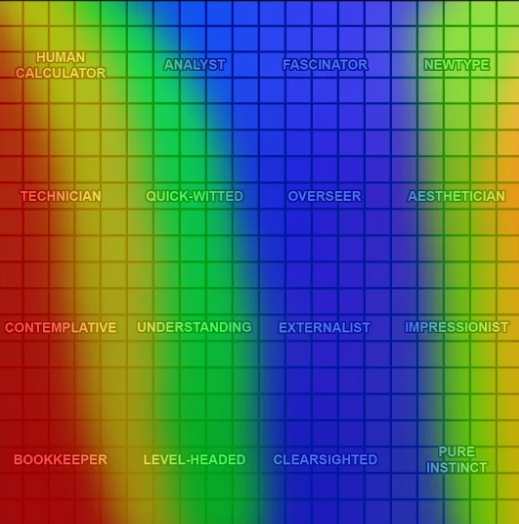 Stroop effect: Delay in reaction time between congruent and incongruent stimuli. (Words of colors are written with random colors. The subject must list out of all the font colors for each word as fast as possible.)
I’m assuming I’m pretty average at this. Maybe a little better. Red = harder time.
Stroop effect: Delay in reaction time between congruent and incongruent stimuli. (Words of colors are written with random colors. The subject must list out of all the font colors for each word as fast as possible.)
I’m assuming I’m pretty average at this. Maybe a little better. Red = harder time. - Simon Effect
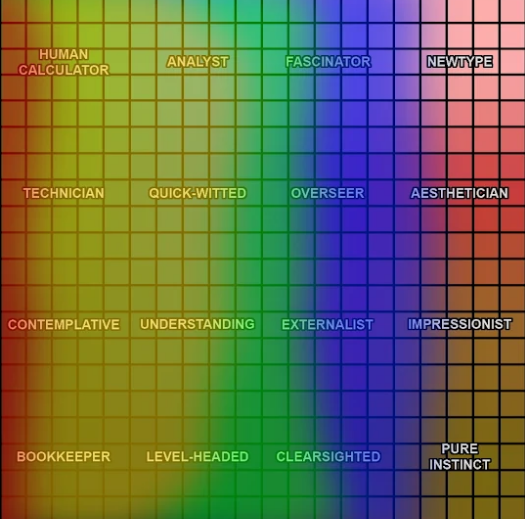 . The words “Left” and “Right” are periodically pasted in either the left or right side of the screen. The subject must press a button on their left if the word is “left” and a button on their right if the word is “right”.
I got 109ms on my first try which is relatively bad. Red = easier time.
3 & 4.
. The words “Left” and “Right” are periodically pasted in either the left or right side of the screen. The subject must press a button on their left if the word is “left” and a button on their right if the word is “right”.
I got 109ms on my first try which is relatively bad. Red = easier time.
3 & 4.
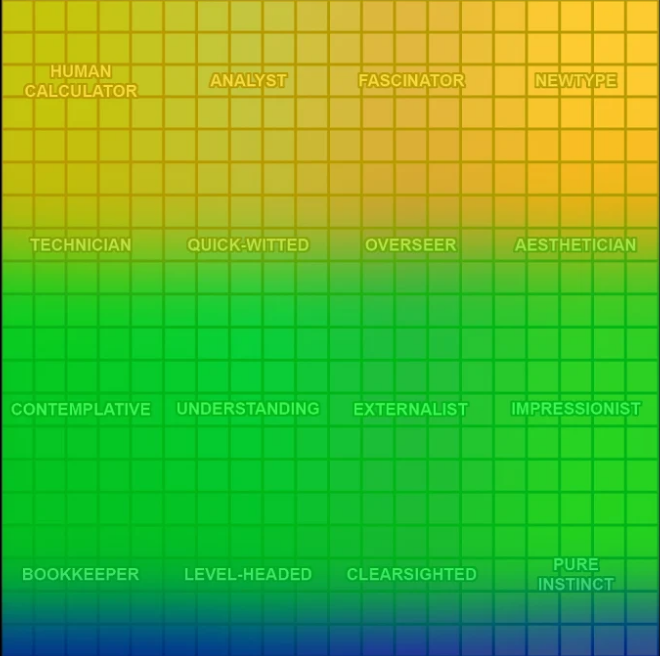 & N-Back. Progressive matrices basically implies laterality is correlated with IQ, which some people will get mad about
Timecake says 8-9+/14 of his examples for <1 minute each starts to put you in the yellow. I got 11 with ease, grinded through one (pretty sure I got it) and got an educated guess on another. I was getting there with the last one; maybe if I had like 5 or 10 spare minutes in a real IQ test. Tfw midwit.
For N-back, timecake says >60% on n=2-back and false positive <20%. I tryharded after learning what to do and got 89% with 6% false alarm. It’s trippy though and hard to do without just letting my AI take over a bit.
& N-Back. Progressive matrices basically implies laterality is correlated with IQ, which some people will get mad about
Timecake says 8-9+/14 of his examples for <1 minute each starts to put you in the yellow. I got 11 with ease, grinded through one (pretty sure I got it) and got an educated guess on another. I was getting there with the last one; maybe if I had like 5 or 10 spare minutes in a real IQ test. Tfw midwit.
For N-back, timecake says >60% on n=2-back and false positive <20%. I tryharded after learning what to do and got 89% with 6% false alarm. It’s trippy though and hard to do without just letting my AI take over a bit. -
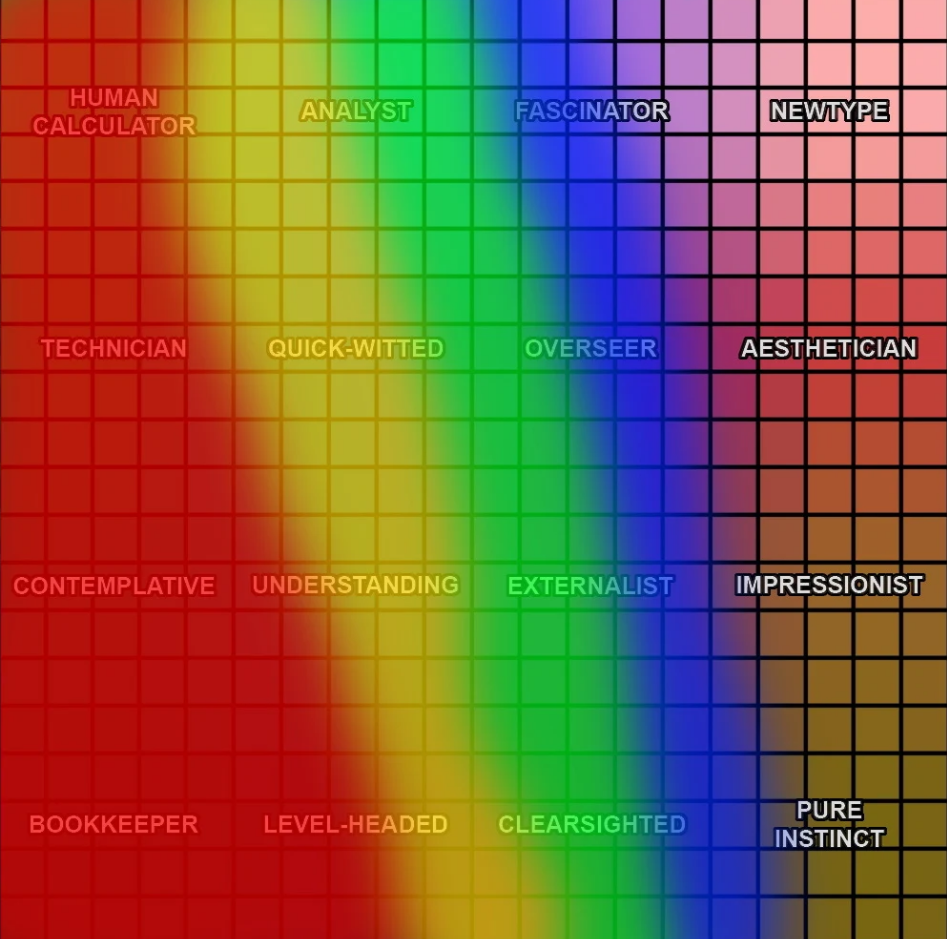 Pretty easy. Red = local time - global time <100ms. Mine is -9, so. Honestly I think this one is pretty inconsequential in the grand total. Most people got negative scores.
Pretty easy. Red = local time - global time <100ms. Mine is -9, so. Honestly I think this one is pretty inconsequential in the grand total. Most people got negative scores. -
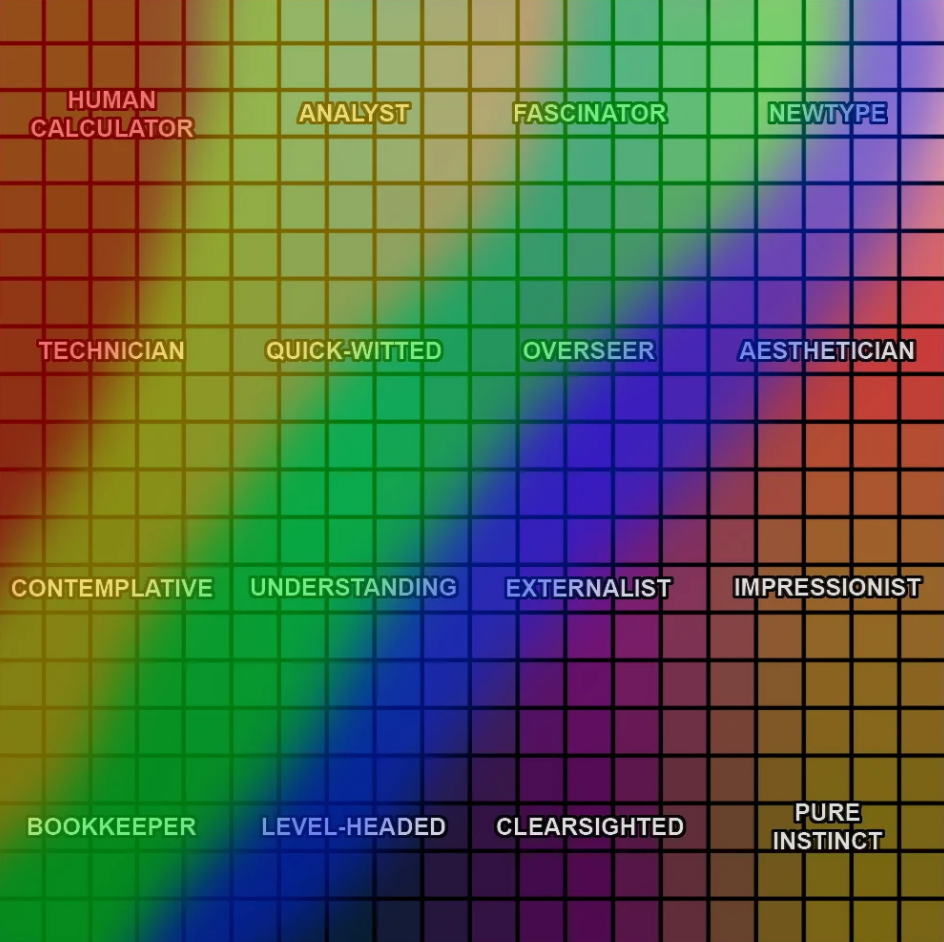 14 word sets, spend no more than 30 seconds. Red = ~10 correct associations. 4/13. The ones I got were basically immediate or else it’s a dead end.
14 word sets, spend no more than 30 seconds. Red = ~10 correct associations. 4/13. The ones I got were basically immediate or else it’s a dead end. -
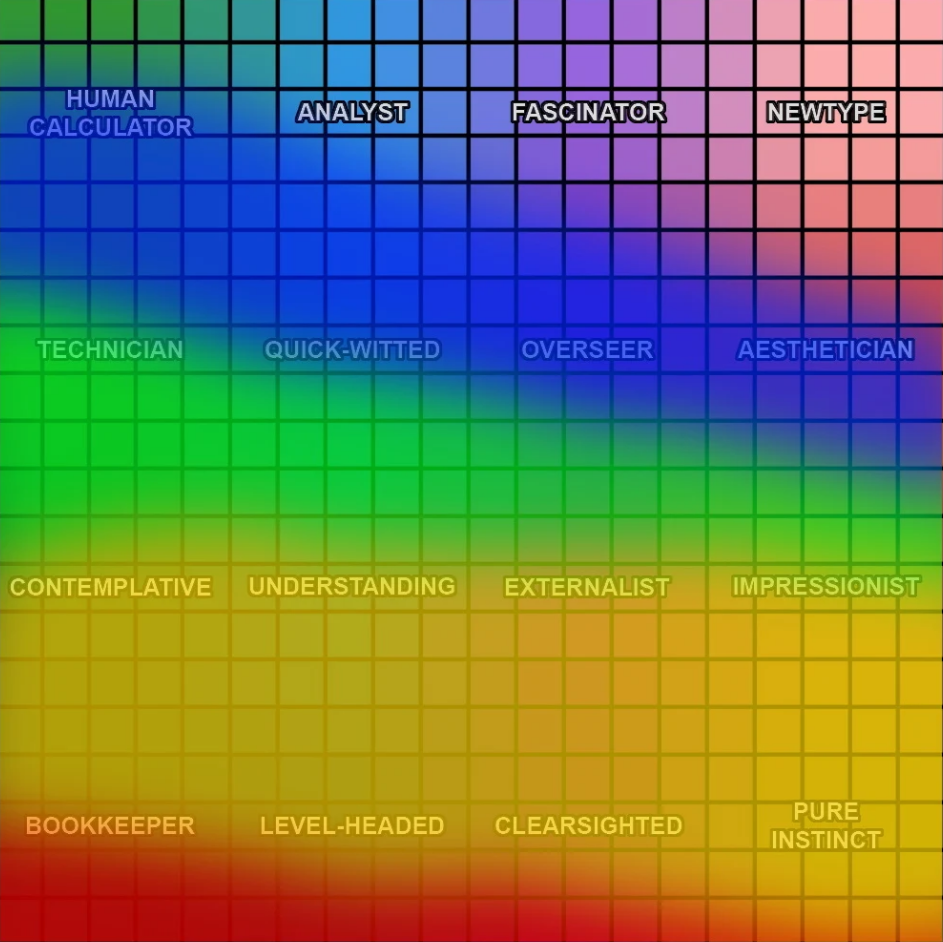 6 Perseveration errors. >~13 brings you into the red.
6 Perseveration errors. >~13 brings you into the red. -
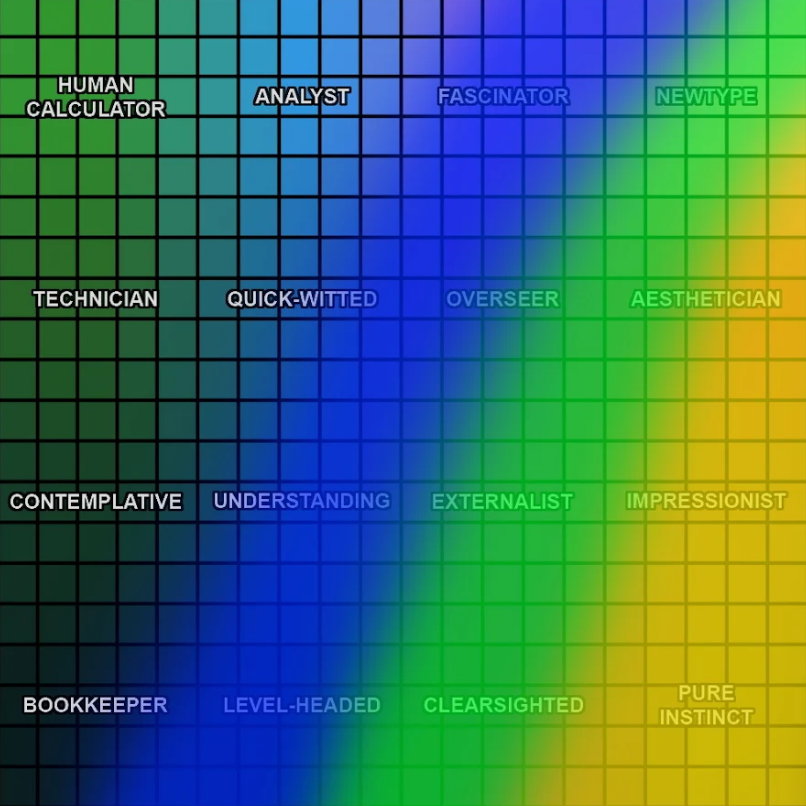 3 non-perseveration errors. >~15 brings you into the red.
3 non-perseveration errors. >~15 brings you into the red. -
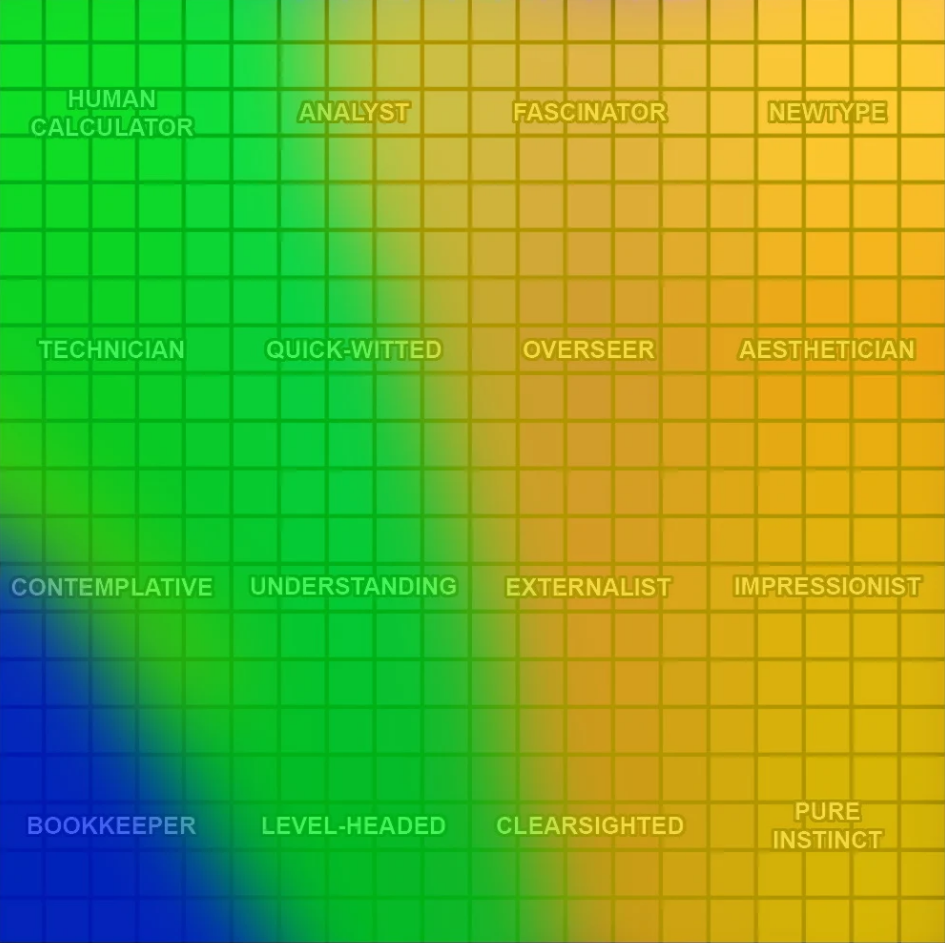 Faster idendification = more to the right. Some of these are countable amounts of lines and I don’t see how you could make images out of them unless you were on acid. Most weren’t hard though.
Faster idendification = more to the right. Some of these are countable amounts of lines and I don’t see how you could make images out of them unless you were on acid. Most weren’t hard though. -
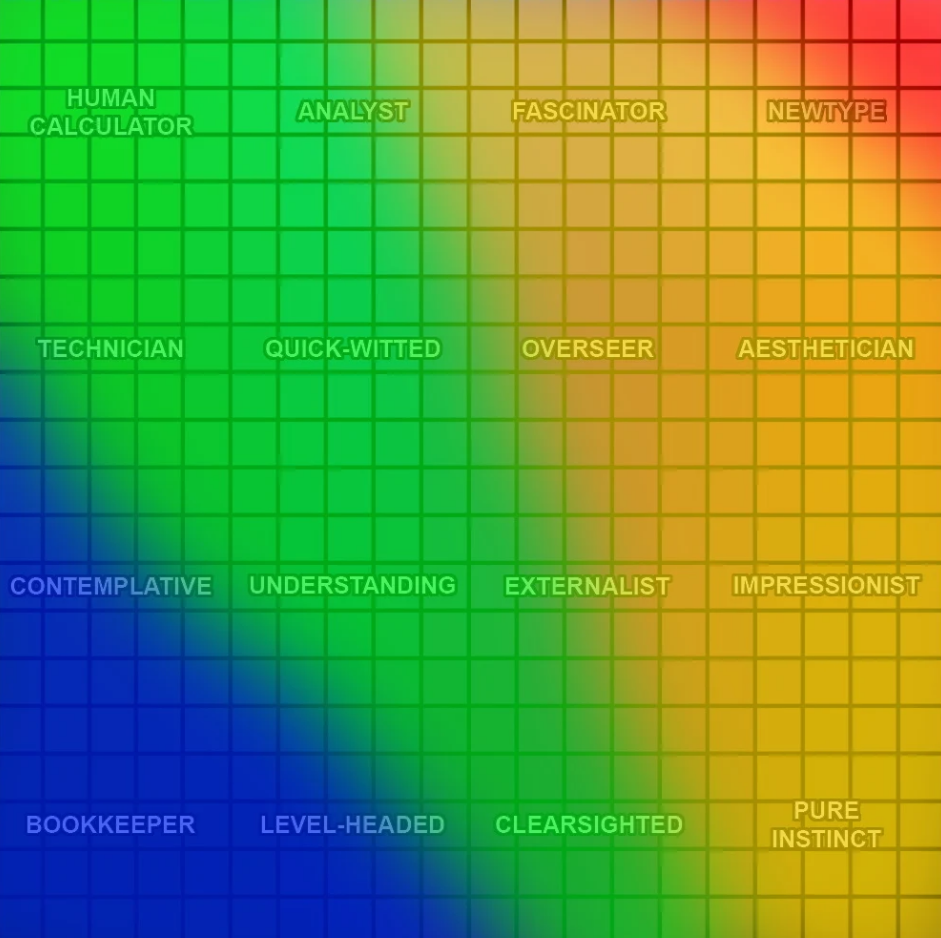 (how many uses can you think of for a brick)? I’m not totally a fan of this test since it requires a lot of energy but eh.
(how many uses can you think of for a brick)? I’m not totally a fan of this test since it requires a lot of energy but eh.
Worldly Abstraction #
-

- Super interesting. I could take notes, but honestly the image speaks for itself. Good shit.
- See: 4E cognition. It’s actually a huge framework apparently.
https://www.oxfordhandbooks.com/view/10.1093/oxfordhb/9780198735410.001.0001/oxfordhb-9780198735410
- Embodied
- Embedded
- Enacted
- Extended
Spatial Variability #
-
https://docs.google.com/document/d/16MaB5vpWqLxFoAzf8GZNpK9WFGCtqNMC8V-4x18W36I/edit
- "…hemispheric asymmetries in structural connectivity are a fundamental constraint of brain architecture and may be the cause for functional hemispheric specialization. These hemispheric differences in structural connectivity, which have been found both at the level of intra-areal microcircuits and inter-regional connections, are likely to form the structural substrate of different functional principles of information processing in the two hemispheres."
- There is a correlation between lateral thinking and Intelligence.
- Disproportional right hemisphere activaion during insight problem solving
-
Trade-offs between robustness and small-world effect in complex networks: https://www.nature.com/articles/srep37317
- We suggest that the robustness-oriented optimization will weaken the small-world effect and vice versa.
